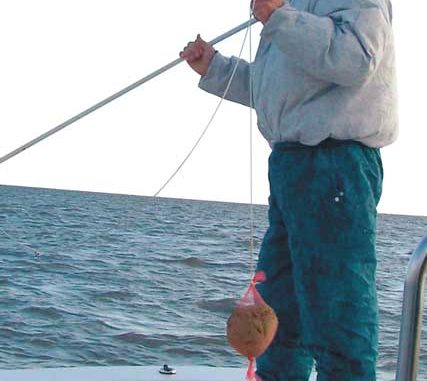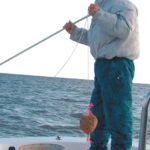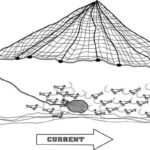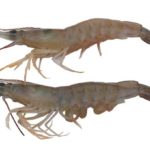
Opening of shrimp-baiting season calls for big nets, homemade concoctions and plenty of fun.
The sun was just beginning to come up over the Atlantic as Johnny Spitzmiller and Marc Deschenes launched Spitzmiller’s boat at Buck Hall Landing near Awendaw — with a day of shrimp baiting at hand.Spitzmiller, a Mount Pleasant native, shared a secret. “Most people come out here at night to catch shrimp, and they may be out here until 2 a.m. before they get their limit” he said. “I value my sleep more than that, besides, it’s not really necessary to throw the net in the dark to get these shrimp.”
Buck Hall Landing sits on Awendaw Creek, just a couple of miles off Bulls Bay, which is rather unique when it comes to South Carolina coastal waters.
The bay’s backwaters provide protection from the open ocean, yet the bay never narrows enough to be considered an inlet. At its mouth, it is some 6½ miles wide, stretching from Northeast Point on Bull Island to Sandy Point south of Cape Romain.
According to Spitzmiller, the constant influx of water from the open ocean causes the bay to stay pretty murky, especially on a northeast wind, and that provides great cover to cast net shrimp during the day.
Spitzmiller operates Ambush Inshore Charters (843-971-0537); he often gets referrals from Deschenes who operates VIP Adventures, a bass-fishing outfitting operation in Summerville. The two are long- time friends and couldn’t resist taking a break from fishing to have a go at splitting a cooler full of fresh shrimp.
“I don’t know of anybody who shrimps the way we do,” quipped Deschenes, while Spitzmiller motored his 21-foot center-console Sea Pro out of the Intracoastal Waterway and into Bulls Bay. “It took us a while to figure out the best way, but now we can go just about every day of the season and limit in just about two or three hours, depending on the weather.”
Monitoring his depthfinder, Spitzmiller kept a close eye on a flat that was split by a meandering creek channel. He remained at the helm while Deschenes moved to the bow to begin preparing the baits for the 10 poles that the S.C. Department of Natural Resources allows. The two guides prefer stout, ¾-inch, 15-foot-long fiberglass poles. Using a long pole isn’t critical early in the season, but it plays a major role as the season progresses and shrimp move to deeper water.
“When the season first opens, we’ll shrimp on flats that range from two to five feet deep, and then as the season progresses, we’ll move out to the edge of a channel where we can find water in the 6- to 12-foot range” said Spitzmiller. “Toward the end of the 60-day season, we are on the deep edges of those channels, and there won’t be a whole lot of poles left sticking up.”
Shrimp baiters in South Carolina must apply for a permit, which includes tags that are placed on each pole. Poles cannot be more than one inch in diameter and must be marked with reflective tape. Each boat is allowed one set of 10 poles, and all poles must be placed within a 100-yard circle.
“Most people make up a big mud ball of bait and throw it out in the vicinity of their poles,” Deschenes said. “That’s a pretty inefficient way of putting out bait.”
To prove his point, Deschenes held up a mesh onion sack tied on a 5-foot length of cord and connected near the bottom of each of his poles. Each sack contained a bait ball slightly larger than a grapefruit that looked like ammunition for a mud cannon.
“We use a 10-foot net, which means that the net has a 5-foot radius,” Deschenes said. “That way, when one of us throws the net right up next to the pole, we know that the net’s horn is settling right over the top of the bait, and that’s where all the shrimp are congregated.”
The pair even has a strategy for placing their poles. As we watched another boat setting out poles, Deschenes pointed out the mistakes the other boat was making.
“Most people run down a creek and stick a pole every 10 yards” he said. “As the tide moves in or out of that creek, all of the scent from his bait gets washed in a straight line. That means the first two or three poles on the downcurrent side will have some shrimp on them, and the last seven or eight poles won’t have much at all. He might as well only put out two poles, plus, his scent trail is only about 10 feet wide.
“On the other hand, if you find an area that is wide enough to place all of your poles perpendicular to the current, there will be shrimp on all of them, and the scent trail that is washing downcurrent will be 100 yards wide.”
Lining up the poles against the current seemed like a great idea, but the two guides also make optimal use of the wind and tide when it comes to throwing the net.
“I always want the wind at my back when I’m throwing the net,” Spitzmiller said. “That means that you have to find a spot that has all three factors in your favor: current, wind and depth. As for the tide, having good water movement is important for dispersing bait and drawing in shrimp. The last three hours of an incoming tide is probably my favorite. “
Spitzmiller and Deschenes pinpointed an open flat on the northern end of the bay and began setting up shop. After waiting 30 minutes for the bait to begin drawing in shrimp, Deschenes climbed up on the bow as Spitzmiller maneuvered the boat into position.
“Those sacks of bait will drift downcurrent from the pole, so I always approach from that side,” Spitzmiller said. “When the net hits the water, it’s important to let it settle all the way to the bottom. Those shrimp are crawling over that bait like ants, and you want the net to settle wide open all around them. When the half-inch mesh lays down, they will pop straight up in the water column. All the netter has to do is hang on and let the backing of the boat close the net. That just buries shrimp deeper in the cast net and means less strain on the thrower.”
After Deschenes hauled in his first throw, a laugh erupted when the billowing net hit the surface. “This ain’t gonna take long,” Deschenes said, referring to the dozens of shrimp flipping on the deck.
“I was hoping we could get done and still have some tide left,” Spitzmiller crowed, “because all this bait in the water means we can catch more than just shrimp.”








Be the first to comment